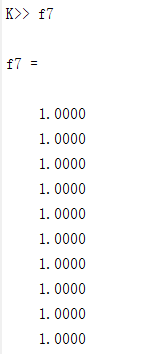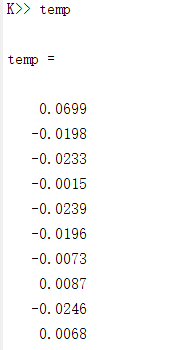Thanks for your response!
This is the cvx output.
Calling SeDuMi 1.3.4: 1516 variables, 620 equality constraints
For improved efficiency, SeDuMi is solving the dual problem.
------------------------------------------------------------
SeDuMi 1.3.4 by AdvOL, 2005-2008 and Jos F. Sturm, 1998-2003.
Alg = 2: xz-corrector, Adaptive Step-Differentiation, theta = 0.250, beta = 0.500
eqs m = 620, order n = 617, dim = 1517, blocks = 301
nnz(A) = 20395 + 0, nnz(ADA) = 63192, nnz(L) = 40332
it : b*y gap delta rate t/tP* t/tD* feas cg cg prec
0 : 1.65E+11 0.000
1 : 3.85E+11 9.84E+10 0.000 0.5947 0.9000 0.9000 6.59 1 1 4.6E+00
2 : 3.35E+10 3.87E+10 0.000 0.3935 0.9000 0.9000 4.98 1 1 6.3E-01
3 : -9.18E+08 1.63E+09 0.000 0.0420 0.9900 0.9900 1.48 1 1 1.1E-01
4 : -4.30E+07 3.23E+07 0.000 0.0198 0.9900 0.9900 1.11 1 1 9.0E-02
5 : -6.59E+05 3.65E+05 0.350 0.0113 0.9945 0.9945 1.05 1 1 7.0E-02
6 : -1.36E+05 7.56E+04 0.000 0.2069 0.9000 0.9000 1.01 1 1 7.0E-02
7 : -8.78E+04 3.87E+04 0.000 0.5115 0.9592 0.9000 0.93 2 2 7.4E-02
8 : -1.04E+06 1.86E-19 0.000 0.0000 0.8950 0.9000 0.02 9 9 1.1E-06
9 : -1.35E+08 5.85E-22 0.000 0.0031 0.9990 0.9990 -0.85 13 13 7.7E-07
10 : -7.70E+09 1.86E-23 0.000 0.0318 0.9900 0.9900 -1.43 31 32 1.1E-06
11 : -1.44E+11 1.06E-24 0.000 0.0571 0.9900 0.9462 -1.02 29 31 1.1E-06
Run into numerical problems.
iter seconds digits c*x b*y
11 0.4 Inf -1.5281375353e+11 -1.4420903211e+11
|Ax-b| = 3.7e+02, [Ay-c]_+ = 9.2E-07, |x|= 2.1e+17, |y|= 1.2e+05
Detailed timing (sec)
Pre IPM Post
2.010E-01 6.300E-01 1.200E-02
Max-norms: ||b||=1.425903e+10, ||c|| = 30,
Cholesky |add|=14, |skip| = 0, ||L.L|| = 500000.
------------------------------------------------------------
Status: Inaccurate/Solved
Optimal value (cvx_optval): -1.44209e+11
This is the original optimization code.
cvx_solver sedumi
cvx_begin
variable X(MB, K) complex;
expressions f6 f7(K) f8(L) f9;
%% The expressions' formulation
%% The variables such as a_, b_, and so on are pre-defined.
for k = 1 : K
f6 = f6 + 2 * sqrt(1 + a_(k)) * real(alpha_(k)' * (f_d(:, k)' + phi' * F_r(:, :, k) * H_B) * X(:, k));
for kk = 1 : K
f6 = f6 - square_abs(alpha_(k)) * square_abs((f_d(:, k)' + phi' * F_r(:, :, k) * H_B) * X(:, kk));
end
for ll = 1 : L
f6 = f6 - square_abs(alpha_(k)) * square_abs((g_i(:, k)' + phi' * F_r(:, :, k) * H_S) * W_S(:, ll));
end
f6 = f6 - square_abs(alpha_(k)) * Sigma2_B;
end
for l = 1 : L
f6 = f6 + 2 * sqrt(1 + b_(l)) * real(beta_(l)' * (g_d(:, l)' + phi' * G_r(:, :, l) * H_S) * W_S(:, l));
for ll = 1 : L
f6 = f6 - square_abs(beta_(l)) * square_abs((g_d(:, l)' + phi' * G_r(:, :, l) * H_S) * W_S(:, ll));
end
for kk =1 : K
f6 = f6 - square_abs(beta_(l)) * square_abs((f_i(:, l)' + phi' * G_r(:, :, l) * H_B) * X(:, kk));
end
f6 = f6 - square_abs(beta_(l)) * Sigma2_S;
end
for k = 1 : K
f7(k) = f7(k) + 2 * real(p_(k)' * (f_d(:, k)' + phi' * F_r(:, :, k) * H_B) * X(:, k));
for kk = 1 : K
if kk ~= k
f7(k) = f7(k) - square_abs(p_(k)) * square_abs((f_d(:, k)' + phi' * F_r(:, :, k) * H_B) * X(:, kk));
end
end
for ll = 1 : L
f7(k) = f7(k) - square_abs(p_(k)) * square_abs((g_i(:, k)' + phi' * F_r(:, :, k) * H_S) * W_S(:, ll));
end
f7(k) = f7(k) - square_abs(p_(k)) * Sigma2_B;
end
for l = 1 : L
f8(l) = f8(l) + 2 * real(q_(l)' * (g_d(:, l)' + phi' * G_r(:, :, l) * H_S) * W_S(:, l));
for ll = 1 : L
if ll ~= l
f8(l) = f8(l) - square_abs(q_(l)) * square_abs((g_d(:, l)' + phi' * G_r(:, :, l) * H_S) * W_S(:, ll));
end
end
for kk = 1 : K
f8(l) = f8(l) - square_abs(q_(l)) * square_abs((f_i(:, l )' + phi' * G_r(:, :, l) * H_B) * X(:, kk));
end
f8(l) = f8(l) - square_abs(q_(l)) * Sigma2_S;
end
for k = 1 : K
f9 = f9 + X(:, k)' * X(:, k);
end
maximize(f6);
subject to
for k = 1 : K
f7(k) >= SINR_B;
end
for l = 1 : L
f8(l) >= SINR_S;
end
f9 <= P_B_max;
cvx_end;
cvx_status_W = cvx_status;
%% The reconstruction of the expressions.
%% The constraints with f7 and f8 are not satisfied.
f7 = zeros(K, 1);
f8 = zeros(L, 1);
f9 = 0;
for k = 1 : K
f7(k) = f7(k) + 2 * real(p_(k)' * (f_d(:, k)' + phi' * F_r(:, :, k) * H_B) * X(:, k));
for kk = 1 : K
if kk ~= k
f7(k) = f7(k) - square_abs(p_(k)) * square_abs((f_d(:, k)' + phi' * F_r(:, :, k) * H_B) * X(:, kk));
end
end
for ll = 1 : L
f7(k) = f7(k) - square_abs(p_(k)) * square_abs((g_i(:, k)' + phi' * F_r(:, :, k) * H_S) * W_S(:, ll));
end
f7(k) = f7(k) - square_abs(p_(k)) * Sigma2_B;
end
for l = 1 : L
f8(l) = f8(l) + 2 * real(q_(l)' * (g_d(:, l)' + phi' * G_r(:, :, l) * H_S) * W_S(:, l));
for ll = 1 : L
if ll ~= l
f8(l) = f8(l) - square_abs(q_(l)) * square_abs((g_d(:, l)' + phi' * G_r(:, :, l) * H_S) * W_S(:, ll));
end
end
for kk = 1 : K
f8(l) = f8(l) - square_abs(q_(l)) * square_abs((f_i(:, l )' + phi' * G_r(:, :, l) * H_B) * X(:, kk));
end
f8(l) = f8(l) - square_abs(q_(l)) * Sigma2_S;
end
for k = 1 : K
f9 = f9 + X(:, k)' * X(:, k);
end
The problem is a little complicated. I think it may be the problem with the solver tolerance. Is there any solution to deal with the solver tolerance problem?
Thanks for your response again!

